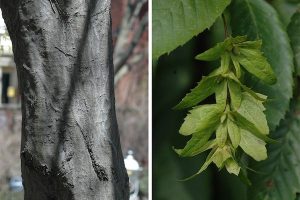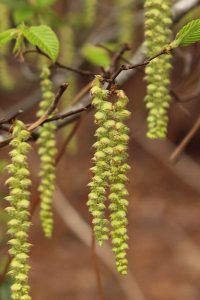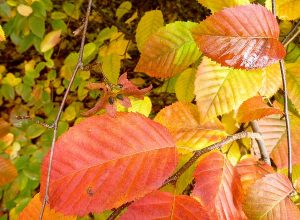The American Hornbeam: Unsung Native of Many Names
By Elaine Pugh, Fairfax Master Gardener

Bark and leaves
What do you do when you want to plant a small native tree, but you have a small shady yard? You might consider Carpinus caroliniana, the American hornbeam. The first time I saw this tree, the smooth bluish-gray bark caught my eye, and I had to know what it was.
The American hornbeam is a small- to medium-sized native deciduous tree with a height and spread of 20 to 35 feet. Its globular often irregular form can be found with either individual or multiple tree trunks. Older trees may exhibit a more crooked trunk with pendulous, zig-zagging branches. The Hornbeam name comes from the horn-like polish of the extremely hard wood that was once used to make bowls, tool handles and ox yokes. The bark is bluish-gray and smooth, which gives it the name Blue Beech. The older branches show muscle-like fluting that gives it another name — Musclewood. The hard wood gives it the name Ironwood. The soil wetness tolerance and beech-like leaves gives it the name Water Beech.

Male Catkins
The American hornbeam is a member of the Betulaceae (Birch) family and the only native tree in the Carpinus genus. It is found in the understory of eastern mixed hardwood forests in the eastern and central parts of the country from Maine to Florida (Zones 3 to 9). Native plants by their very nature attract wildlife. Finches and other songbirds, gray squirrels, ruffed grouse, ring-necked pheasants, bobwhite quail, turkeys and foxes enjoy eating its seeds, buds or catkins. It is a host plant for the Eastern tiger Swallowtail and Red-spotted Purple caterpillars. Cottontails, beavers and white-tailed deer eat the leaves, twigs and larger stems. Beavers also use the wood to make dams.
The flowers in early spring are separate for male and female and look like small icicles of white and green catkins. The white female flowers are 2 to 3 inches long and the male flowers are 1 to 1 1/2 inches long. The female flowers produce the seeds as a cluster of winged nutlets about 1/3 inch long attached to the three-lobed bracts.
The leaves are simple, alternate and elliptical in shape with parallel veins and double serrated edges. The fall color is good and varies from bright red to a combination of red, orange and yellow.

Fall color
The versatility of the American hornbeam surprised me. I receive a lot of requests for shade-loving plants. This tree prefers part shade to full shade but can tolerate full sun where it becomes more dense and uniform. It can handle the clay soils of Northern Virginia. It prefers deep, fertile, moist, slightly acidic soils with a pH. range from 4.0 to 7.2 but will tolerate some intermittent drought. It is resistant to frost damage. This tree is basically a disease- and insect-free tree. The only occasional disease problems include cankers, leaf spots and twig blight. It should be transplanted in the spring, preferably balled-and-burlapped, and should be available from most large local nurseries in the spring. The American hornbeam can be used as a specimen tree, in naturalized plantings, as part of the general landscape, in tight locations or as a small street tree. A Fairfax County document on Resource Protection Areas recommends it as an understory tree for both flood plains and areas adjacent to floodplains.
The American hornbeam can be easily confused with its cousin, the European hornbeam, Carpinus betulus. They both have the smooth bluish-gray bark and similar leaves. As you look very closely, the American hornbeam has distinct brownish-black buds that extend out from the stem. The European hornbeam has larger reddish-brown angular buds suppressed against the stem. Not easy to tell. However, the European hornbeam becomes a much larger tree that grows 40 to 60 feet tall by 40 to 60 feet wide, is not a native tree and prefers full sun to any shade.
With look-a-likes and many common names, the best way to ask for this tree at the nursery may be to ask for it by its Latin name, Carpinus caroliniana. The American hornbeam is a wonderful addition to a small yard and one that you should consider for yours.
References
• American Hornbeam, University of Kentucky
• American Hornbeam, M. Dubin, Glen Arboretum, Towson University
• American Hornbeam, MSU Extension
• Carpinus caroliniana, Missouri Botanical Garden
• Carpinus caroliniana, North Carolina State Extension
• Underutilized Landscape Plant: Carpinus Caroliniana, Penn State Extension
• Recommended Tree and Shrub Species for Reforestation of Resource Protection Areas, Fairfax
County, DPWES, Forest Conservation Branch, Urban Forest Management Division, June 4, 2008
• Dirr’s Hardy Trees and Shrubs, An Illustrated Encyclopedia, by Michael A. Dirr